B. PLANNING
B1. Examination of GHG emission report and Multi-criteria policy assessment
.The purpose of this step is to establish a clear picture of ‘where we are’, a description of the city’s current situation in terms of energy and climate change.
If you think it can be useful to have a more comprehensive outlook of your municipality a SWOT analysis can be an useful strategic planning tool that can be applied in MAP development. Based on the findings of the GHG emission report and on the Multi criteria policy assessment, it allows determining the Strengths and Weaknesses of the local authority in terms of energy and climate management, as well as the Opportunities and Threats that could affect Process. This analysis can help to define priorities when devising and selecting actions and measures.
TIPS:
• Before starting take into account all the plans and policies that you have already developed and carefully analyze the GHG emission inventory to select sectors that need priority action;
• Evaluate all the possible policies that could be included in your plan by looking at the Multi-criteria policy assessment and select the most relevant or applicable to your context;
• Do not forget the work you have already done, the GHG emission report and the multi-criteria policy assessment are operative tools to take into consideration at this point.
LAKS TOOLS:

B2. Long term visions definition and Target setting
The long term vision is the guiding principle of your municipality’s work for the Mitigation and Adaptation Plan. It points out the direction in which the local authority wants to head. A comparison between the vision and the local authority’s current situation is the basis for identifying which actions are needed to reach the desired objectives. The vision is the uniting component that all stakeholders can refer to, meaning everyone from leading politicians to citizens and interest groups.
You have to select the target and the time span for reaching your emission reduction taking into account these considerations.
We suggest to consider the Covenant of Mayors’ commitments, (i.e. it should imply that the 20% CO2 emission reduction in the 2020 target will be reached (at the minimum) as a basis on which you can build on. Do not worry if you have difficulties in setting this target, also a lower commitment can be a good starting point for a long term process.
The following step to undertake is the definition of your GHG emission reduction target, expressed as % of reduction on total emissions of the baseline year selected. This step is fundamental for a successful plan. In order to select a feasible target it is important to evaluate the potential of GHG emission reduction of your municipality and the political commitment and willingness. Depending on the local context you can choose an overall emission reduction target or a per-capita emission reduction.
Once the overall target is well established, it is necessary to translate it into more specific objectives and targets, for the different sectors in which the local authority intends to take action.
TIPS:
• The target you select needs to be feasible and shared with key decision makers of local administration and relevant stakeholders;
• Choose either an absolute reduction or a per capita reduction depending on your local context (e.g. rapid population growth or decreasing population);
• Choose a long term vision that is realistic but provides something new, add real value and break some old boundaries that do not have real justification any more. It should describe the desired future of the city and be expressed in visual terms to make it more understandable for citizens and stakeholders;
• Choose targets and objectives that are: Specific, Measurable, Achievable, Realistic, and Time-bound.
LAKS TOOLS:
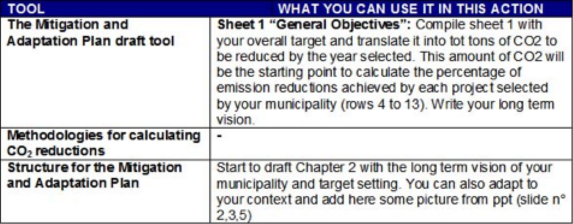
An example: Reggio Emilia’s target setting:
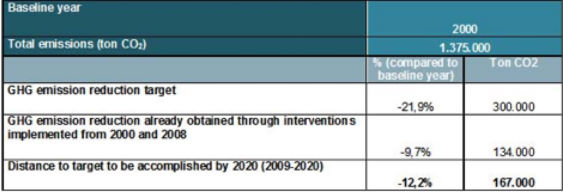
B3. Assurance of technological and financial support from local stakeholders
For a successful drafting and implementation of the Plan it is important to involve, since the beginning of the process, key stakeholders that can give either technological or financial support to those projects that will be included in the plan. The entire process can be therefore coherent with accountability standards that foreseen in stakeholder engagement one of its pillars (see box on Accountability 1000).
Essential is the selection of local stakeholder that can be useful for the implementation of municipality’s strategy. The ideal process foresees the following steps:
• Mapping of stakeholders and different degree of involvement:
The first step is to identify the main stakeholders. The stakeholders are those:
o Whose interests are affected by the issue;
o Whose activities affect the issue;
o Who possess/control information, resources and expertise needed for strategy formulation and implementation;
o Whose participation/involvement is needed for successful implementation.
Mapping stakeholders is fundamental to select how to involve them in order to make it useful for the process. Depending on their role the involvement can be basically divided into three different segments:

Selection of relevant stakeholders for involvement and consultation: choose in your local contexts actors that have the technical and/or financial competencies that can be strategic to design the intervention of the mitigation and adaptation plan and that therefore can be involved at higher degree, some of them might be:
financial partners such as banks, private funds;
ESCOs – Energy Service companies;
institutional stakeholders like chambers of commerce;
chambers of architects and engineers;
energy suppliers, utilities;
transport/mobility players;
private/public transport;
renewable energy industries;
other business offering innovative technologies that might be applied in the plans (e.g. smart technologies for energy efficiency etc..)
• Organization of working groups with selected stakeholders: these working groups should be activated at the very beginning of the process in order to involve key actors from the beginning of the plan. The idea is to build a step by step partnership between the municipality and the local business, in particolar those that can spread new tecnlogoies and solutions and that can insert in the plan new solutions or projects. It is important to share with them the priorities and what they will be willing to finance, the technological innovation they can develop, the type of renewable energies on which is better to focus on etc. The key aspects of this process is that it guarantees the feasibility of the projects that will be included in the plan and it allows to actively involve these crucial actors. In addition to that their involvement can also lead to positive drivers for local economic innovation in terms of green economy.
Key actors that should be involved are the financial institutions and other organizations that would provide resources should be involved
• First selection of feasible projects: the output of these working groups should be the shared definitions of projects that can be included in the plan in the following actions.
Define with the participants the projects that can be included in the plan.
TIPS:
• Involve new actors and actively look for interesting experiences already implemented in your local context;
• Do not focus only on the usual contacts;
• Focus groups have to be carefully planned in order to have effective results:
o Choose experienced facilitators for the meetings management;
o Define a precise programme of workshops and plan accurately the working sessions (e.g, 1° meeting: project objectives, what is the MAP, what you need from them etc.; 2° meeting: the interventions they already implement to reduce co2 emissions, new feasible projects, way for financing these projects etc.);
o Define the outputs of each meeting.
• Some stakeholders can have conflicting interests: in this case it is advisable to organise preliminary meetings for each particular group separately to understand the conflicting interests before bringing them together.
• Build up a continuous stakeholder engagement with frequent updating, peer review in order to maintain a strong link for the entire process with relevant actors and make them being feeling part of the process.

Focus: The AA1000 Stakeholder Engagement Standard (AA1000SES)
In the AA1000 Framework Standard published in 1999, AccountAbility first introduced the principle of inclusivity. Inclusivity is the participation of stakeholders in developing and achieving an accountable and strategic response to sustainability. Stakeholder Engagement is a tool that organisations use to help them achieve inclusivity. To support the achievement of inclusivity, guidance on how to design and conduct stakeholder engagement was included in the 1999 AA1000 Framework Standard. By 2005, this early guidance had evolved into the AA1000 Stakeholder Engagement Standard, the first international standard on stakeholder engagement to be published. While stakeholder engagement is not new, it is now accepted as crucial to an organisation’s sustainability and success. To date, however, it has been difficult to fully understand what is good or poor quality engagement. The purpose of this standard is to establish the benchmark for good quality engagement.
Stakeholders are not just members of communities or non-governmentalorganisations. They are those individuals, groups of individuals or organisations that affect and/or could be affected by an organisation’s activities, products or services and associated performance with regard to the issues to be addressed by the engagement. Stakeholder engagement then is the process used by an organisation to engage relevant stakeholders for a clear purpose to achieve accepted outcomes. It is now also recognised as a fundamental accountability mechanism, since it obliges an organisation to involve stakeholders in identifying, understanding and responding to sustainability issues and concerns, and to report, explain and be answerable to stakeholders for decisions, actions and performance.
Quality stakeholder engagement must:
• be based on a commitment to the AA1000APS principles;
• clearly define the scope;
• have an agreed decision making process;
• focus on issues material to the organisation and/or its stakeholders;
• create opportunities for dialogue;
• be integral to organisational governance;
• be transparent;
• have a process appropriate to the stakeholders engaged;
• be timely; and
• be flexible and responsive.
Engaging with the individuals, groups of individuals or organisations that are affected by or can affect an organisation’s activities, and responding to their concerns makes organisations perform better. It increases their knowledge and contributes to their license to operate.
Quality stakeholder engagement can:
• Lead to more equitable and sustainable social development by giving those
who have a right to be heard the opportunity to be considered in decision-making
processes;
• Enable better management of risk and reputation;
• Allow for the pooling of resources (knowledge, people, money and
technology) to solve problems and reach objectives that cannot be reached
by single organisations;
• Enable understanding of the complex operating environments, including
market developments and cultural dynamics;
• Enable learning from stakeholders, resulting in product and process
improvements;
• Inform, educate and influence stakeholders to improve their decisions and
actions that will have an impact on the organisation and on society; and
• Contribute to the development of trust-based and transparent stakeholder
relationships.
B4 Development of the Plan
This action is the core of the entire process as it foresees the development of your Municipality’s Mitigation and Adaptation Plan. In order to describe how an ideal process should be implemented we have divided this action in four steps that are not listed in chronological order as they can be undertaken at the same time.
Before starting this part, you have to decide how to divide your time span in actions to be implemented in the short period (more or less 3 years from the moment you start developing the plan) and the long period (depending on the year you have chosen for reaching your target). This is crucial to make a feasible plan and to define timing, expected CO2 reductions and financial investments.
1. Recognition of already implemented actions
The first step is to review all the actions that your Municipality has already planned from the baseline year to the year you have selected for you target. These actions can be both already implemented or just planned.
In order to revise the document you have to select and analyze the plan depending on your local context, some documents that might include projects related to CO2 savings that might be useful are:
o energy plan;
o urban plan;
o mobility plan;
o green areas and parks plan
In addition to that it might be useful to organize focused interviews to identify the interventions already implemented both by the local administration and by relevant stakeholders. For what concerns your municipality it might be useful to define meetings with councillors in order to check with them if what you have found in official documents is still valid.
TIPS:
• Remember to always refer to the source from where you have found the interventions (official documents, plans, pages etc.);
• Select only those actions that have been specifically described (timing, indicators, expected results, responsible etc) and that are still valid;
• When you meet the councillors make sure that you already have a list of interventions to check with them;
• At the end of this process calculate the overall emission reductions already obtained (starting from baseline year) thanks to already implemented projects and calculate the distance to target. This percentage has to be covered by the new interventions your municipality will commit to implement:
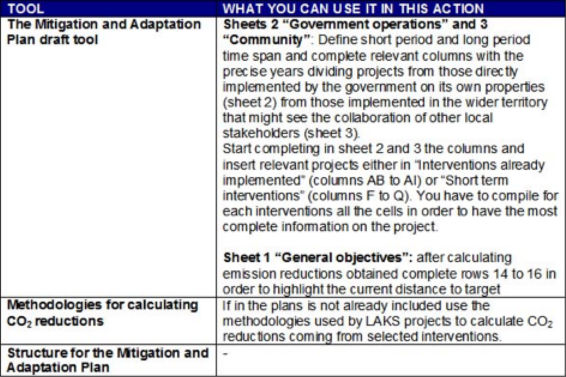
2. Definition of short term and long term actions
At this point, you have to start identifying new interventions that can contribute to CO2 emission reductions at local level. This part can be realized with different and complementary methods:
• Start with the list of feasible interventions you have identified during the multi-criteria policy assessment;
• Integrate any interventions that has emerged from the workshops with stakeholders (see Action B3);
• Organize interviews with relevant secision makers (e.g. Urban planning, energy, mobility councillors etc.) in order to define with them project interventions.
TIPS:
• When you meet the decision makers make sure that you have already developed a list of proposed and feasible interventions to be implemented in the local context;
• Organize the meetings in order to also update decision makers on the development of the project;
• In this phaseit is fundamental to work with all municipality’s sectors, coordination among all actors is a key aspect for the successful implementation of this action;
• Identify specific deadlines in order to define which interventions will be realized in the short term and which are foreseen just in the long run;
• Directly involve the mayor to add specific projects because in this action the most critical aspect is that probably the target cannot be reached with a first round of projects defined with councillors. If this is the case the support of the mayor can help in meeting all councillors again, highlighting that the committed target has not been reached yet and that they need to identify integrative strategies to reduce CO2 emissions.
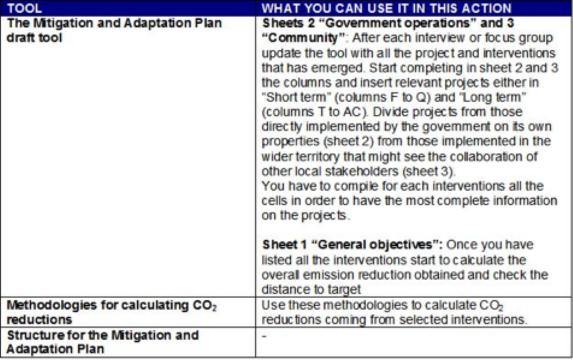
3. Drafting the plan
Before starting drafting the plan it is important to revise with all decision makers the main projects defined in order to have their final approval. This can be done with a specific focus group where the MAP staff can present the main results obtained to councillors and to the mayor.
At this point you can start drafting the final version of your plan using the word document format attached.
In the plan, after the first introduction chapters, you have to start listing all the interventions you have selected and a goal for each sector. At the end of the plan in attachment for each action foreseen in the short period and in the long period you have to complete a template identifying, at least:
- Sector
- Intervention description
- Responsible
- Timing (end-start, major milestones)
- Cost estimation
- Estimated energy saving/increased renewable energy production
- Estimated CO2 reduction
In this part you can decide to aggregate interventions coming from different sectors of the government operations segment and community segment in order to make the plan easier to read and more communicative. A possible sector aggregation can be done following the example of Padova and Reggio Emilia (from 15 sectors to 5 areas of intervention). In any case, you are free to develop your own aggregation in accordance with the necessities of your local context.
An example: sectors aggregation in Padova and Reggio Emilia:
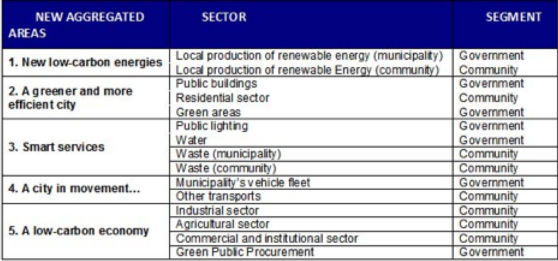
TIPS:
• For the focus group with decision makers it can be useful to prepare a short power point identifying for each sector the main projects, consequent CO2 emission reductions, political and technical responsible, timing etc;
• Try to draft the plan with a strong communicating approach in order to make it an easy to read document that can be diffused also to your citizens;
• Decide if you prefer to limit in the first part the description of projects to just a simple statement as all the technical information of the plan are included in attachment in the tables with projects description; Clearly number the projects so that there is a clear correspondence with technical description in attachment;

B5 Plan presentation to relevant stakeholders
Presentation of the draft of the plan: the stakeholders will be involved also at the end of the process when the map staff will present the first draft of the Plan to have feedbacks from them. This presentation can be done, accordingly to local strategy, by organizing multi-stakeholder focus groups or by organizing small focus groups with homogeneous groups of stakeholders (e.g citizens, actors involved in the working groups, energy providers, business representatives etc.).
TIPS:
• For the focus group with stakeholders, prepare a short power point identifying for each sector the main projects, consequent CO2 emission reductions, political and technical responsible, timing etc.
• Prepare to answer to the following questions that might arise:
o How did you calculate co2 emissions in the inventory?
o How did you calculate co2 emissions reduction?
o Why did you choose that baseline?
o What kind of financial resources are available to implement the project?
o Did you also take into account the increase of co2 emissions that will probably happen in your territory?
B6 Approval of the Plan
The last step is the final approval of the plan. In order to have a real political commitment and to make the plan becoming strategic for your municipality, Municipality’s council approval is fundamental.
TIPS:
• Make sure that relevant councillors and the mayor has already given their approval to the plan before the official council session;
• After the official approval you can consider to organize a conference to present the plan to a wider public inviting citizens, journalist etc.



